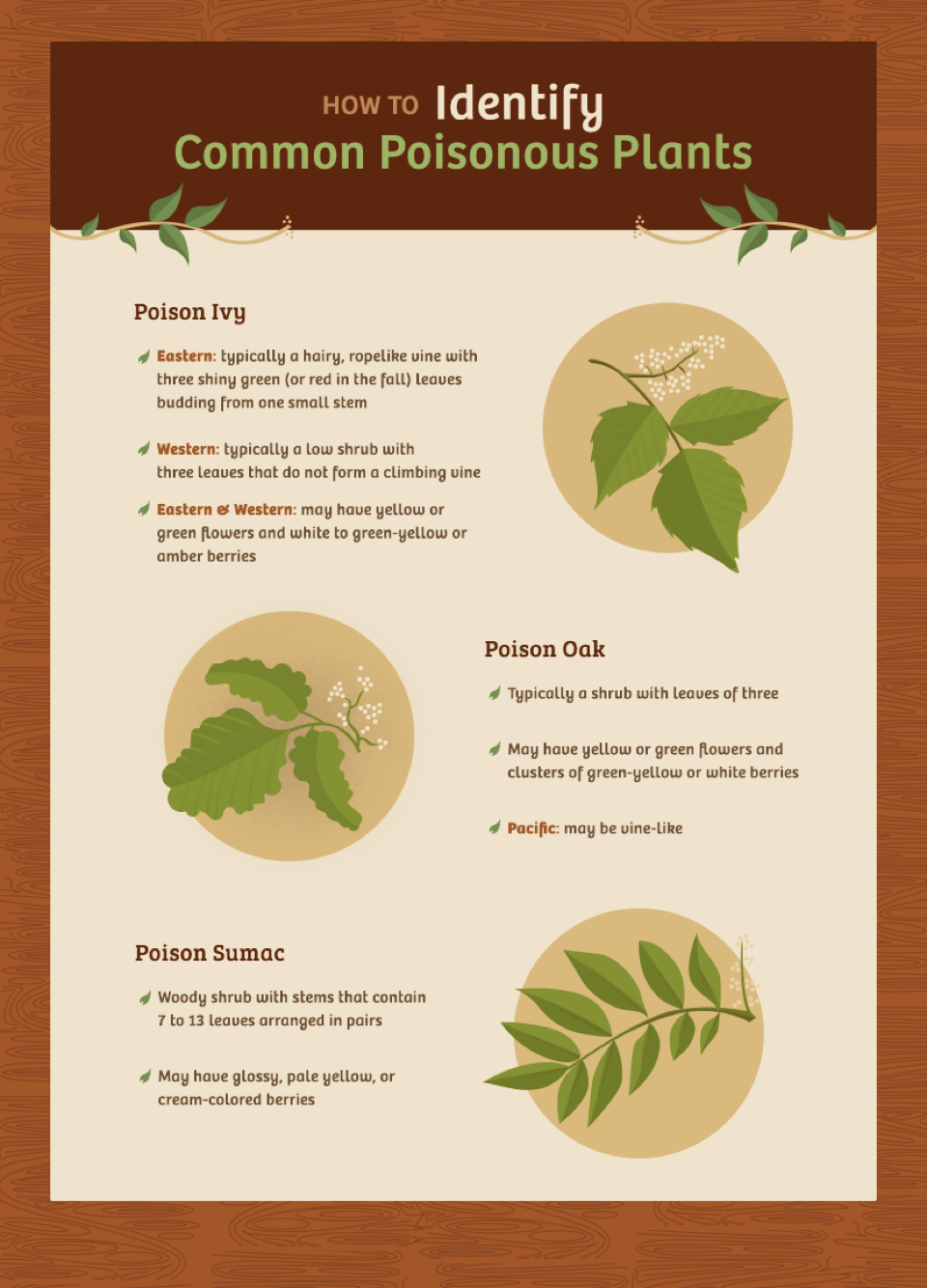One surefire way to ruin a picture-perfect outing is to come in contact with poisonous plants and suffer the consequences: unbearably itchy skin rash, headaches, dizziness, nausea – the list goes on and on. How can you avoid these poisonous green party poopers? It’s all about knowing what to look for.

Although a number of plants can provoke a skin reaction, three major poisonous culprits tend to cause an irritating skin rash: poison ivy, poison oak, and poison sumac.
All three of these plants contain an oily sap called urushiol. This sap is located in the plant’s leaves, stems, and roots, and it is quite sticky, so it easily adheres to skin, clothing, pet fur, gardening tools, and more. Urushiol is so strong that if contaminated objects aren’t properly cleaned, the oil can cause a reaction even later. That’s one reason why it’s so important to thoroughly clean camping equipment when a trip is over.
After it comes in contact with skin, urushiol triggers an allergic reaction that usually results in a red, itchy rash called allergic contact dermatitis. Although this is rarely anything more than a bothersome inconvenience, the severity of the reaction depends on the amount of contact with the plant. The initial rash can spread within hours of exposure, or it may take several days to appear. Typically, the first sign of a reaction appears in the form of straight red lines that gradually become more itchy and swollen. In some cases, blisters may appear. (Contrary to popular belief, the fluid inside the blisters is not contagious.1)

When it comes to identifying poisonous plants, the old adage, “leaves of three, let it be” may be a good rule of thumb, but it’s not exactly foolproof. Both poison oak and poison ivy have three leaves. Depending on the exact species, time of year, location, and other factors, the leaves can have distinct textures and colors. Poison sumac is typically a cluster plant with up to 13 leaves.
Now that we have slightly disproved the three-leaf theory, we can move on to identifying local varieties throughout the seasons. All three plants can be found in most areas of the United States, excluding Alaska, Hawaii, and the deserts of the Southwest. Depending on the location, each plant can have a distinct appearance.
Poison ivy is a prolific plant that grows well along road edges or in areas that are not heavily trafficked. It’s found mainly in the Eastern, Midwestern, and Southern regions, where it is fairly widespread thanks to the birds and deer that eat poison ivy berries.
Although you can generally identify poison ivy by its three leaves, it has a chameleon-like quality that turns the leaves different colors and textures depending on location. The leaves can have dull or glossy leaflets with smooth or jagged edges. Sometimes the leaves are hairy, and sometimes they are not.
When trying to avoid poison ivy, it is essential to be aware of its regional appearance. In the East, Midwest, and South, poison ivy often grows as a vine, but in the northern regions, it grows as a shrub that can spread along the ground and climb on low plants, trees, street signs, telephone poles, and more.
Eastern poison ivy is typically recognized by its hairy, rope-like, vine appearance with three shiny green (red in the fall) leaves budding from one small stem. Western poison ivy is typically a low shrub with three leaves that does not form a climbing vine.
Typically, poison ivy leaves are reddish in spring, green in summer, and yellow, orange, or red in fall. In the spring, poison ivy “blooms” with yellow or greenish-white flowers and light yellow or amber berries, which ripen in the summer.2
Poison oak is most commonly found in the western United States, although it can also grow in the eastern states. It is rarely found in the Midwest. It can grow as a vine or a low-lying shrub, and its leaves are typically shaped similar to oak leaves.
Mature poison oak leaflets are a dull green and are typically more jagged or “toothed” than poison ivy. Like poison ivy, it has leaves of three, but unlike poison ivy, poison oak leaflets have hairs on both sides. The leaves can have yellow or green flowers and clusters of green-yellow or white berries.
Poison sumac (also known as thunderwood) is less common than poison ivy and poison oak. The plants grow as woody shrubs or small trees that can grow up to 30 feet in dense, swampy areas, such as Florida and other parts of the Southeast. Although not very common in the north, it can be found in extremely wet, wooded areas along the northeastern United States and even into Canada.
Poison sumac stems usually have no hair and 7 to 13 leaves per stem that are 2 to 4 inches long. The leaves have smooth edges and pointed tips, and they usually have a red stem that stretches along the leaflets. The plant flowers with greenish clusters that can sprout glossy, pale yellow or cream-colored berries.
Although less common, poison sumac is thought to be more virulent than both poison ivy and poison oak. Often, the reaction caused by sumac contact is more intense, resulting in a more painful, long-lasting rash and swelling.

This Retro WON first appeared June 9, 2017.
The Women's Outdoor News, aka The WON, features news, reviews and stories about women who are shooting, hunting, fishing and actively engaging in outdoor adventure. This publication is for women, by women. View all posts by The WON